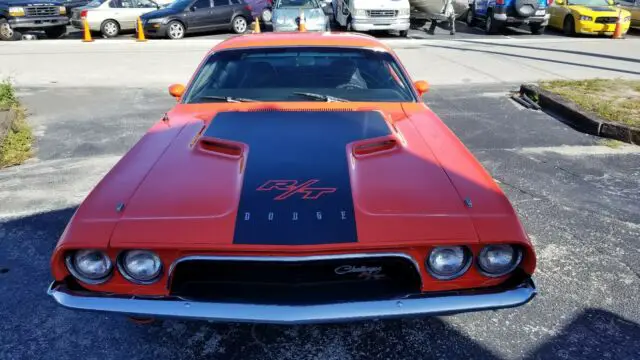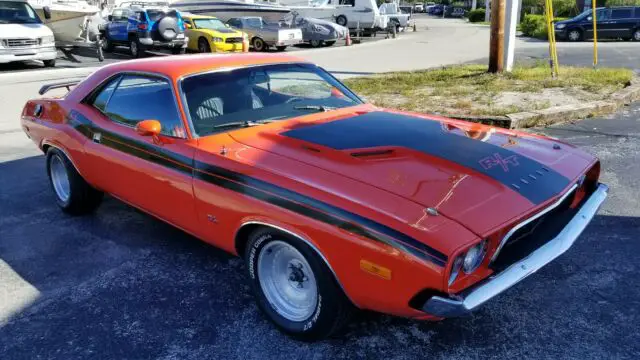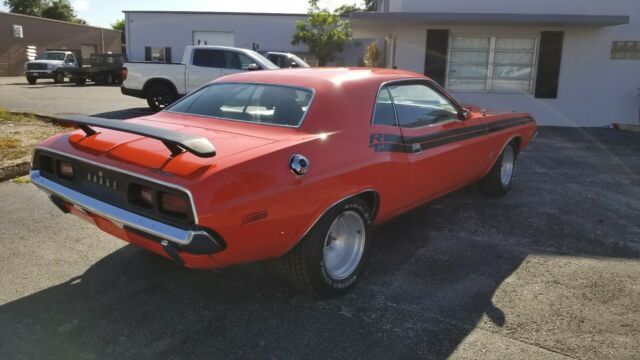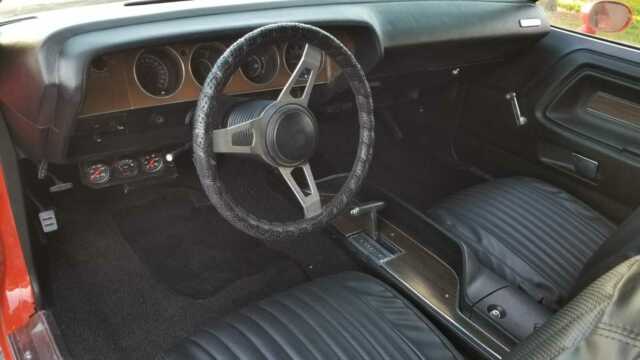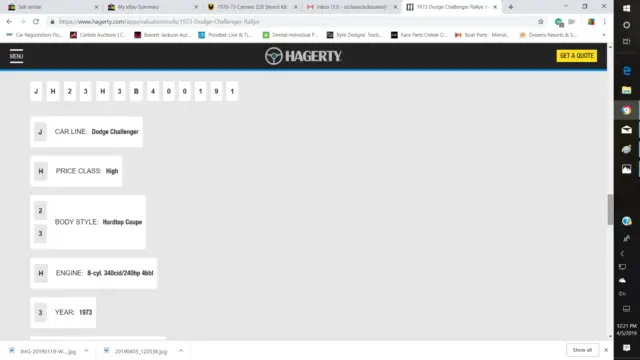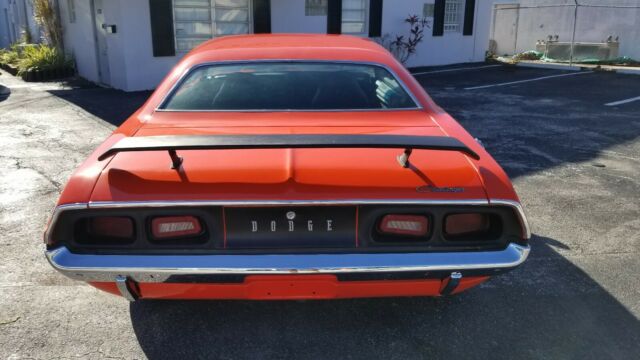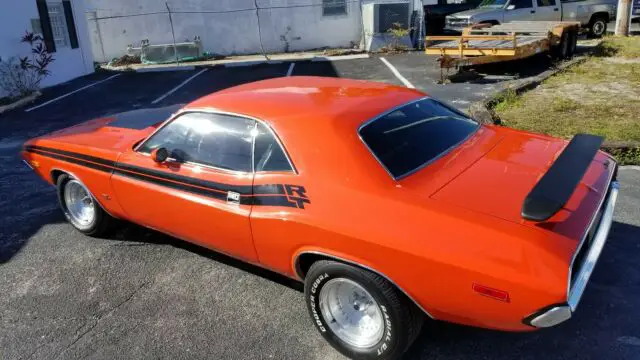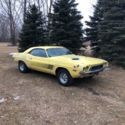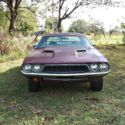1973 DODGE Challenger Rallye R/T package tribute 1971 440 magnum
| Make: | Dodge |
| Model: | Challenger |
| SubModel: | Rallye |
| Type: | Coupe |
| Trim: | Challenger |
| Year: | 1973 |
| Mileage: | 99999 |
| VIN: | JH23H3B400191 |
| Color: | Hemi-Orange |
| Engine: | 440 |
| Cylinders: | 8 |
| Fuel: | Gasoline |
| Transmission: | Automatic |
| Drive type: | RWD |
| Interior color: | Black |
| Drive side: | Left-hand drive |
| Vehicle Title: | Clear |
| Item location: | Pompano Beach, Florida, United States |
1973 Dodge Challenger Challenger Additional Info:
1973 DODGE Challenger Rally tribute R/T package 1971 440, CAR DESPITE NOT MATCHING ENGINE OEM 340 ENGINE NOW UPGRADED TO 440 MAGNUM MOPAR WITH EDELBROCK 4 BARREL CARB 800CFM AND ELECTRONIC IGNITION SYSTEM, NEW COOPER TIRES, REBUILT ENGINE 4000 MILES, NEW FLOW-MASTER EXHAUST SYSTEM WITH HEADERS, NEW BRAKE SYSTEM ALL REPLACED, ROTORS, LINES, CALIPERS, PUMP, NEW GAS TANK AND METE, NEW CARPET AND SEAT COVERS, NEW SUSPENSION AND SHOCKS, REAR AIR SHOCK, THIS CAR IS IN EXCELLENT CONDITIONS DESPITE WAS PAINTED HEMI ORANGE 2 YEARS AGO AND IS VERY CLEAN ANYHOW WAS COMPLETELY RESTORED AT THAT TIME (30K INVESTED) IS A 46 YEAR OLD CAR...TOO MANY THINGS TO LIST DESPITE YOU CAN SEE THE VIDEO LINKS FOR THE UNDERCARRIAGE WALK AROUND AND ENGINE TEST RUN BY CLICKING OR OPENING IT.THE CAR WILL BE DELIVERED FOR FREE IN THE USA 48 STATES ONLY BUY IT NOW FULL PRICE (NOT BEST OFFER UNLESS HAS BEE AGREED UPON).VIDEO LINK:https://www.youtube.com/watch?v=lpcJzSt0MRo
The vehicle is in my warehouse in Pompano Beach and we'll assist with the shipping process at buyer's own cost unless buy it now.
Year: 1973VIN: JH23H3B400191Make: DodgeModel: ChallengerMiles: K milesEngine: 440/Magnum 8 cyl 7.2LTSTransmission: automaticDoors: coupeInterior: BlackExterior: Hemi-OrangeOPTIONS• Power Steering• Radio• Power Brakes• Vinyl Leather Interior• Cragar AR wheels• Front Seat Belts• Transmission• Speedometer: Yes RPM gauge• Temperature Gauge: YES• Fuel Gauge: Yes• Turn Signals: Yes• Headlights: HEAD LIGHTS• Wipers: Yes• Horn: Yes• Brake Lights: Yes• OEM Radio: Yes•EngineRuns: Yes• Heater: n/a• Tail Lights: Yes
COMPARE THE CARS WITH PACKAGES
1971 Dodge Challenger R/T2dr Hardtop Coupe 8-cyl. 440cid/385hp 3x2bbl
- Download Vehicle Report (PDF)
- Add to Favorites
Prefer doing business in person?Connect with an agent in your area
Jump To:- Current & Historical Values
- Past Sales
- Vehicles for Sale
- VIN Decoder
- Articles & Videos
Image is general in nature and may not reflect the specific vehicle selected.
History of the 1971 Dodge Challenger R/TDodge was still selling power and performance in 1971, but the writing was on the wall. Challenger sales dropped from 83,032 to 29,883 while the Barracuda did even worse, falling from 55,499 to 18,690. Visually, the 1971 Dodge Challenger changed little. The grille was now divided into two pieces, as were the taillights.The numbers tell the story. The Challenger line was trimmed to four models in three series. The vast majority of 1971 Challengers (27,900) had V-8 engines. Only 2,165 convertibles were sold, along with 4,630 R/T hardtops.
This would be the last year for the ground-pounding 425 bhp 426 cid Hemi. Chrysler had pulled out of Trans Am racing, so the Challenger T/A went away as well. Convertible sales had fallen so far that this was the last year. The SE series was discontinued, though the roof was optional as a trim package. Chrysler also reduced compression ratios and cut warranties.
The best-selling Challenger model was the standard two-door Hardtop, with 23,088 finding buyers. Prices started at $2,858 with the slant six and $2,950 with the 230 bhp 318 cid V-8. A basic two-door coupe with fixed rear side windows could be bought from $2,727 with a slant six or for $2,853 with a 318 V-8. The R/T was only available with a V-8.
Optional engines included the 275 bhp 340 cid V-8 for $253, the 300 bhp, 383 cid V-8 for $145, the 390 bhp 440 cid Six Pack V-8 for $460 and the 425 bhp 426 cid dual-4-barrel Hemi V-8 for $790. The base hood was now flat with a slight power bulge, but a shaker hood, twin-scoop R/T hood or 1970 fiberglass T/A hood could be added. The base transmission as still a 3-speed manual, but most people bought an automatic or a 4-speed whose shift lever was moved closer to the driver.
Options included sunroof and front and rear spoilers, rear window louvres, air conditioning and power accessories like seats and door locks. A vinyl roof was popular on base and R/T cars in 1971, and Code A21 coated the front bumper with vinyl, after which it could be color-coded. or blacked out. The Rallye Gauge package was available with a radio group which cost $337 for buyers who ordered the AM/FM cassette. Air conditioning had risen to $374.40. A breaker-less electronic ignition system was introduced.
Dodge offered 18 paint colors on the Challenger, of which five were “high impact.” Base colors and codes were Light Gunmetal (A4), Light Blue (B3), Bright Blue (B5) Dark Blue (B7), Bright Red (E5), Medium Green (F3), Dark Green (F7), Dark Green (F8), Light Green (J3), Dark Burnt Orange (K5), Dark Bronze (K6), Butterscotch (L5), Tan (T2), Bright White (W3), Black (X9), Dark Gold (Y8), and Gold (Y9). Remaining high impact colors included Hemi Orange (V2), Plum Crazy (C7), Bright Yellow (Y1), Green Go (J6), and Citron Yellow (Y3). Panther Pink (M3) was available to special order.
A total of 12 possible interior colors were available. A split bench seat could be ordered on the base Challenger with a column shift. Colors (and combinations) included White, Black, Light Gold, Light Gold Metallic, Medium Gold Metallic, Medium Dark Saddle, Medium Russet, Dark Gold Metallic, Light Blue Metallic, Medium Blue Metallic, Dark Blue Metallic, Dark Blue-Gray Metallic. Other lists add additional colors.
">Dodge was still selling power and performance in 1971, but the writing was on the wall. Challenger sales dropped from 83,032 to 29,883 while theBarracudadid even worse, falling from 55,499 to 18,690. Visually, the 1971 Dodge Challenger changed little. The grille was now divided into two pieces, as were the taillights.
The numbers tell the story. The Challenger line was trimmed to four models in three series. The vast majority of 1971 Challengers (27,900) had V-8 engines. Only 2,165 convertibles were sold, along with 4,630 R/T hardtops.
Show All...1971 Dodge Challenger R/T Info- 0" >
- Body Styles
- 2dr Hardtop Coupe
- 0" >
- Engine Types
- 8-cyl. 383cid/300hp 4bbl Hi-Perf
- 8-cyl. 426cid/425hp 2x4bbl Hemi
- 8-cyl. 440cid/385hp 3x2bbl
- 8-cyl. Special Order
- Additional Info
- Curb Weight: 3495 lbs.
- Vehicle Length: 191.3 in.
- Wheel Base: 110 in.
- Number Produced
- 4,630
- #1 Concours$120,000Condition #1 vehicles are the best in the world. The visual image is of the best vehicle, in the right colors, driving onto the lawn at the finest concours. Perfectly clean, the vehicle has been groomed down to the tire treads. Painted and chromed surfaces are mirror-like. Dust and dirt are banned, and materials used are correct and superbly fitted. The one word description for #1 vehicles is "concours."
- #2 Excellent$92,400
- #3 Good$71,600
- #4 Fair$54,300
+20% for Shaker hood. +15% for 4-spd. Colors can make an astonishing difference in both value and salability.
- About Hagerty's Condition Ratings
- |
- About Our Prices
- 3 YEAR
- 5 YEAR
- ALL
MODEL OVERVIEW 0" ng-include="" src="'/apps/valuationtools/Content/partials/gallery.partial.html'" >1970 Dodge Challenger RT SE Hardtop Coupe
Image is general in nature and may not reflect the specific vehicle selected.
History of the 1973 Dodge Challenger RallyeDespite the fact that there was only one 1973 Dodge Challenger model (the Rallye was a $182 option package), sales actually rose from 26,648 to 32,596. It seems likely that buyers were anticipating the end of the model, as Mercury Cougar sales rose a whopping 60 percent with news that the Mustang/Cougar platform would undergo significant changes the following year.The Challenger actually looked very much like the previous year’s model, though the bumpers were beefed up. The front bumper was pushed out with a beam behind it and big rubber blocks, fitted to meet the 5 mph requirement. With a unibody design, Dodge couldn’t install shock-absorbing pistons, such as were fitted to separate chassis models.
The downward slide continued under the hood, though the slant six engine was gone. Base engine was now a 150 bhp two-barrel 318 cid V-8. For an extra $181 buyers could get the 240 bhp 340 cid V-8. Electronic ignition was standard across the range now with electric chokes. The base gearbox was a 3-speed manual, but $81 bought a 3-speed automatic transmission and $203 a pistol-grip four-speed.
Dodge was also now promising “Extra Care in Engineering” and a “Torsion Quiet Ride” which meant fitting rubber blocks to insulate road noise, as had been installed to the big cars since 1970. Perhaps as an adjunct to this, the bucket seats were now formed of one-piece foam.
Packages were now the buzzword and the Rallye Package A57 was basically a dress-up. It consisted of the twin-scoop hood from the old R/T, black painted grille, faux front fender scoops and a side stripe.
The Challenger was offered in 15 colors with codes, including Light Blue (B1), Super Blue (B3), Bright Blue Metallic (B5), Bright Red (E5), Pale Green (F1), Light Green Metallic (F3), Dark Green Metallic (F8), Bronze Metallic (K6), Parchment (L4), Eggshell White (W1), Top Banana (Y1), Light Gold (Y3), Gold Metallic (Y6), and Dark Gold Metallic (Y9). Top Banana was the sole remaining high impact color. Interior colors were Blue, Green, Gold, White, and Black. A vinyl roof cost $81 and colors included Black, White, Dark, Green or Gold and side stripes were Black.
">Despite the fact that there was only one 1973 Dodge Challenger model (the Rallye was a $182 option package), sales actually rose from 26,648 to 32,596. It seems likely that buyers were anticipating the end of the model, asMercury Cougarsales rose a whopping 60 percent with news that the Mustang/Cougar platform would undergo significant changes the following year.
The Challenger actually looked very much like theprevious year’smodel, though the bumpers were beefed up. The front bumper was pushed out with a beam behind it and big rubber blocks, fitted to meet the 5 mph requirement. With a unibody design, Dodge couldn’t install shock-absorbing pistons, such as were fitted to separate chassis models.
The downward slide continued under the hood, though the slant six engine was gone. Base engine was now a 150 bhp two-barrel 318 cid V-8. For an extra $181 buyers could get the 240 bhp 340 cid V-8. Electronic ignition was standard across the range now with electric chokes. The base gearbox was a 3-speed manual, but $81 bought a 3-speed automatic transmission and $203 a pistol-grip four-speed.
Dodge was also now promising “Extra Care in Engineering” and a “Torsion Quiet Ride” which meant fitting rubber blocks to insulate road noise, as had been installed to the big cars since 1970. Perhaps as an adjunct to this, the bucket seats were now formed of one-piece foam.
Packages were now the buzzword and the Rallye Package A57 was basically a dress-up. It consisted of the twin-scoop hood from the old R/T, black painted grille, faux front fender scoops and a side stripe.
The Challenger was offered in 15 colors with codes, including Light Blue (B1), Super Blue (B3), Bright Blue Metallic (B5), Bright Red (E5), Pale Green (F1), Light Green Metallic (F3), Dark Green Metallic (F8), Bronze Metallic (K6), Parchment (L4), Eggshell White (W1), Top Banana (Y1), Light Gold (Y3), Gold Metallic (Y6), and Dark Gold Metallic (Y9). Top Banana was the sole remaining high impact color. Interior colors were Blue, Green, Gold, White, and Black. A vinyl roof cost $81 and colors included Black, White, Dark, Green or Gold and side stripes were Black.
1973 Dodge Challenger Rallye Info- 0" >
- Body Styles
- 2dr Hardtop Coupe
- 0" >
- Engine Types
- 8-cyl. 318cid/150hp 2bbl
- 8-cyl. 340cid/240hp 4bbl
Visit the Hemmings Car Clubs pages at www.hemmings.com/clubs/ for news and information on over 1,400 car clubs!
YOU'RE BIDDING TO BUY...SO IF YOU'RE NOT SURE DON'T WASTE MY TIME.
NOTE: Sold as seen in pictures. Customers please note every computer shows colors differently. All measurements are approximate. Hardware and instruction/ installation manual not included. Product have some stains, dents, scratches and/or scuffs from use and handling.TERMS /CONDITIONS: These Goods are offered subject to prior sale, withdrawal, without notice. Buyer has right to inspect said Goods prior to final bid. Acceptance of bid shall constitute a binding contract. This sale is "as is, where is," in Ft. Lauderdale, Florida USA, with no warranties express or implied as to condition, quality, or fitness for a particular purpose. Seller shall not be liable under any circumstances for any defects patent, latent, or otherwise. The Buyer acknowledges that no guarantees or warranties were expressed or implied by the Seller or his agent regarding the condition, quality or fitness for any purpose of the Goods.DISCLAIMER: Descriptions of these Goods are offered in good faith but Seller cannot guarantee or warrant the accuracy of this information nor warrant the condition of the Goods. The buyer acknowledges their responsibility to conduct such inspections and inquiries as they deem appropriate.JURISDICTION/VENUE: By placing your bid on this auction for these Goods you agree and accept that the rights and obligations of the parties hereunder shall be determined, in accordance with Florida law without regard to choice of law doctrines. The parties agree to submit to personal jurisdiction of Florida courts for any action relating to or arising under the terms, conditions, disclaimer as set forth above. Venue for any action arising under or relating to this transaction shall be in the court of appropriate jurisdiction for Broward County, Florida. If any proceeding is brought to enforce a parties right under this agreement, the losing party shall pay all costs and attorneys' fees of the prevailing party.these terms are not negotiable.A $500.00 non-refundable deposit is due within the end of the auction close, and the remainder is due within 7 business days of the auctions close, money order, cashier’s check, cash, or bank transfer are acceptable forms of payment. The buyer is responsible for shipment or pick of this vehicle. The cars need to be picked up within 10 days of the auction end. Storage charges will be accumulated thereafter. Please ask questions before biding, and bid to buy, not to come and see if you want the car. AS IS - NO Warranty As-Is No Warranty This vehicle is being sold as is, where is with no warranty, expressed written or implied. The seller shall not be responsible for the correct description, authenticity, genuineness, or defects herein, and makes no warranty in connection therewith. No allowance or set aside will be made on account of any incorrectness, imperfection, defect or damage. Any descriptions or representations are for identification purposes only and are not to be construed as a warranty of any type. It is the responsibility of the buyer to have thoroughly inspected the vehicle, and to have satisfied himself or herself as to the condition and value and to bid based upon that judgment solely. The seller will make every reasonable effort to disclose any known defects associated with this vehicle at the buyer's request prior to the close of sale. Seller assumes no responsibility for any repairs regardless of any oral statements about the vehicle.WE'RE NOT CAR DEALERS AND AND THERE'RE NO HIDDEN FEES, WE CANNOT ISSUE TEMP TAGS, ALL THE NECESSARY PAPERWORK MUST BE DONE BY THE BUYER WILL GET A SIGNED (NOT ASSIGNED) OPEN TITLE AND BILL OF SALE UNDER HIS NAME, AND IS HIS SOLE RESPONSIBILITY TO PAY ANY STATE TAXES AND REGISTRATION.INSPECTIONS ARE OPEN M-F FROM 1PM-4PM EST ONLY BY APPOINTMENT (AFTER THE $500 DEPOSIT HAS BEEN COMPLETED), NO TEST DRIVES ONLY SURVEYS AND INSPECTIONS, ENGINE TEST RUN AND MISC ONSITE TEST RUN, THIS CAR HAS NOT BEEN INSURED AND NEITHER HAS A VALID REGISTRATION, SO PLEASE DON'T ASK FOR IT.
